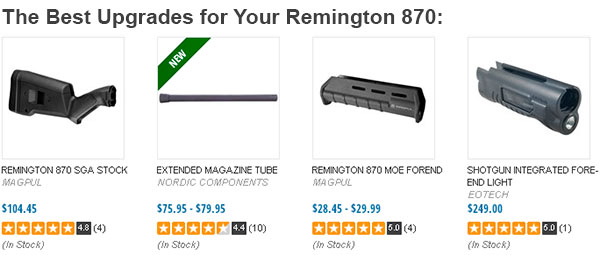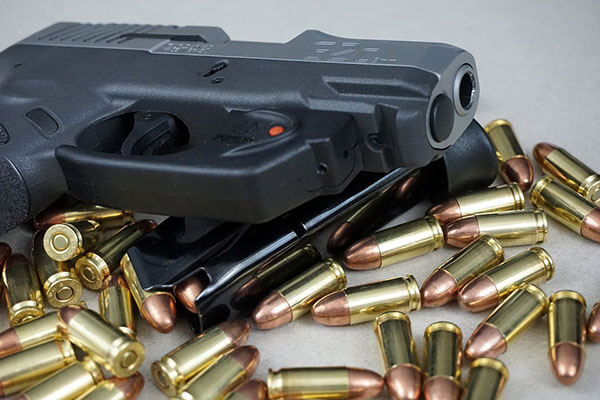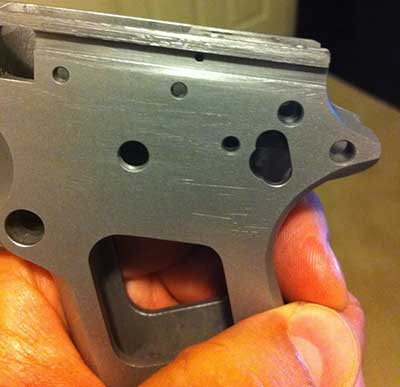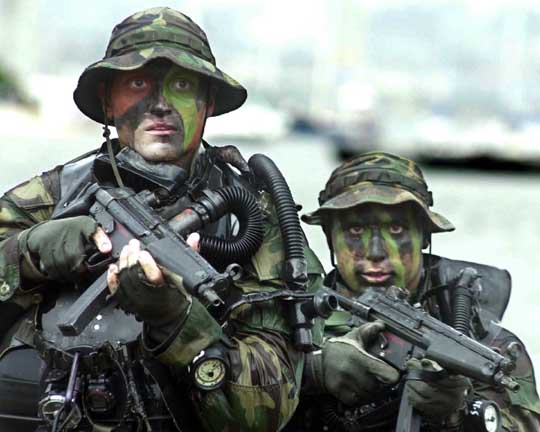Interview with Chris Costa (Costa Ludus, ex Magpul Dynamics)
Chris Costa on Facebook: http://www.facebook.com/Official.Chris.Costa
Costa Ludus training company: http://www.costaludus.com/
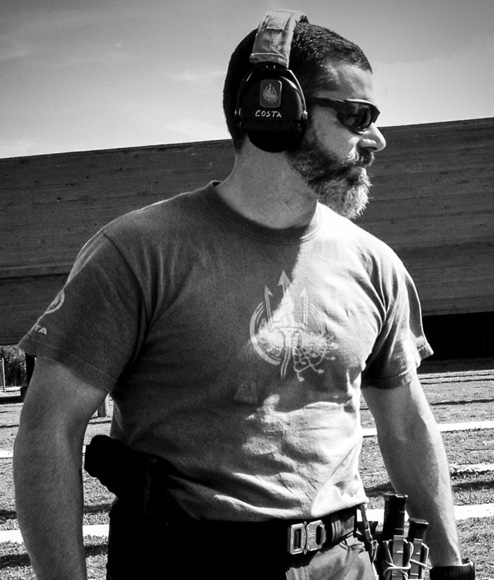
Chris Costa
Interview: Vitaly Pedchenko (Rem870.com)
Editor: Denise Loar
Special thanks to Chris for making this interview possible.
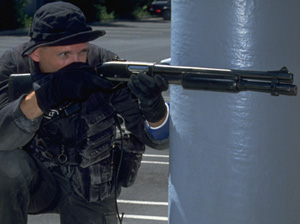 |
Rem870.com: The Rem870.com blog is all about the Remington 870; Chris, what do you think about this shotgun?
Chris Costa: I like the versatility of the 870. It’s an older gun but it works really well, especially when manipulating ammunition. You have the tendency to at least have one more round than you typically do with the Mossberg. And while the Mossberg is a good shotgun, I find it a little clunky. |
In my opinion, the older 870s are some of the best. On those you could actually touch the trigger and pull to the rear on the pump at the exact same time, allowing you to place pressure to the rear on the pump. You could pull the trigger, collapse the gun, and cycle the gun a little bit faster. The newer 870s don’t allow you to do that. On the new 870s you have to be more limber on the pump, pull the trigger, and then cycle the gun really fast; if you don’t, you lock the breach up.
The 870 is a versatile gun. When it comes to pumps, you can run low recoils, slugs, less lethal rounds, and breaching rounds as well. And, of course, since you are dealing with the pump, you can cycle it.
“My home defense gun is a handgun”
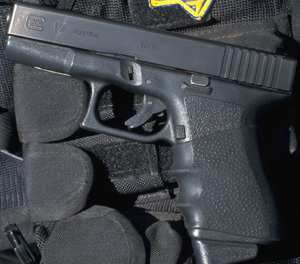 |
Rem870.com: What upgrades would you recommend having on a home defense shotgun?
Chris Costa: Well, here is where it can get a little controversial and complicated. My home defense gun is a handgun. It’s got an X300 Surefire on it and is equipped with a DG Grip switch, which allows me to light and shoot with one hand. I also run a suppressor on it. |
Imagine waking up in the middle of the night and trying to clear your house with an 18” barrel gun – that’s what a shotgun is! You also need to be able to work a light on it while being stealthy and efficient.
If I wake up in the middle of the night, half naked, needing to defend my family and my home, I can shoot and employ my handgun one-handed while I grab my children and maneuver around my house extremely quickly, all the while knowing that I have 17 rounds at my disposal. If you have to grab one of your kids because they’ve popped out in between you and a threat, then you’re stuck trying to fire a 12 gauge one-handed; it can be done (I do it all the time in my demonstrations), but not without a lot of practice, and it’s certainly not ideal.
I also believe that trying to deal with a threat that you can’t see is a much greater concern than one you can see. If there’s an intruder in my house that is visible, then I am actually in the process of solving that particular problem. If there’s someone in my house that I can’t see, that scares me much more. So imagine that you have someone in your house that you can’t see, you don’t have ear protection, and you don’t have a suppressor and are not using a handgun (handguns naturally being quieter than a shotgun) – if you fire that shotgun it’s going to be extremely loud, and you will probably lose your hearing for a few minutes. Those few minutes can be vital, because the intruder now knows where you are and you’re unable to be as alert as you normally would. Having that suppressor addition is very important to me; using a handgun with a suppressor means if it fires a foot and a half from my ears, my hearing is still protected.
So to sum it up, if I clear my house during the night with a handgun, I can shoot suppressed, I can white light, I can work one-handed if I need to grab one of my kids, and if push came to shove I could pistol-punch an intruder with the muzzle of my gun. I can’t do any of that with a shotgun.
When I think of my shotgun as a home defense gun, I imagine that I’m up and alert, waking around the interior of my house or outside the perimeter. I imagine my family is somewhere safe and that I don’t have to worry about shielding them or grabbing them back. When I think of a 12 gauge as a home defense gun, I imagine I’m anticipating an attack and am preparing for whatever chaos may ensue.
Unfortunately, and especially in America, men have a tendency to buy their women 870 shotguns,12 gauge shotguns, or 20 gauge – any shotgun really. And they tell them, “This is for home defense. If you rack it, you’ll scare the intruder away.” But, it just doesn’t work that way. So now you have a woman on the phone with 911, your children behind her, and she needs to pull and manipulate a shotgun while keeping track of her family and talking to the emergency service line. It would be much easier for her to pull out a handgun with a light already integrated onto it, take cover behind the bed to protect herself and the children, and save her family.
And in regards to ‘racking the pump to scare an intruder’ I’m not there to scare the intruder, nor would I want my loved ones to just scare an intruder; I want to shoot the intruder. If someone steps into my home with malicious intent, they get smoked. A pump shouldn’t be used to scare somebody; it should be used to show them that you mean business.
So that’s how I approach the home defense role, and where I see the shotgun and handgun fitting in.
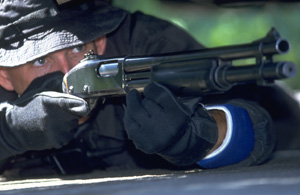 |
Rem870.com: Could you please tell us about your Shotgun Employment (SE) courses?
Chris Costa: In America’s law enforcement you typically find favoritism towards the carbine because of its 28 round capacity. It is a gun that can be manipulated easily and reloaded very quickly. |
Most officers prefer a 28 round capability, while on most shotguns the standard is 5 rounds plus maybe one in a pipe or 4 + 1 in a pipe unless you get an extended tube.
Shotguns are great, however, because they are extremely versatile tools that are very effective. The drawback to shotguns, especially the 870, is that you have to manipulate it in a very particular manner to utilize its effectiveness. The Shotgun Employment course focuses on shooting the shotgun properly, loading it, and changing the ammo from 00 buck to slugs. I pay attention to the hand movements that really bog down students, noting what actions should be taking place during every single moment when you are firing that gun. This prepares my students for when you are dealing with a pump that you have fired, teaching them how to replenish their supply immediately, working on how to be combat-ready by being as quick as possible at reloading the tube. If they need to do a slug changeover, they understand what condition their gun is in, and understand exactly what’s taking place.
So yes, as far the Shotgun Employment course goes – a lot of it is hand movements and a lot of understanding mentally where your gun is at every moment in time. The shotgun is a very complicated weapon system to operate, but we break it down step by step.
“Center the gun up into your chest as much as possible”
Rem870.com: What advice would you give to help people shoot faster and more accurately?
Chris Costa: Center the gun up into your chest as much as possible; don’t rest it on the collarbone – that won’t help you stabilize your weapon. To shoot the gun properly when it’s centered up into your chest, you back the gun up and become as rigid as possible, keeping from being pushed back. Be as symmetrical to the platform as you can to help manage recoil.
On all of my guns the stock of the weapon has been chopped down, so that I only run about a 12.5 length of pull, measuring from the rear of the receiver to the end of the actual rubber. This shortens it into a configuration where I can put it as centerline as possible, helping me keep the gun on target so I can keep pulling on the trigger. If the gun goes off target you have to slow down, readjust, and then fire – this saves you precious time.
Also, it’s worth noting that during my courses or when I shoot in my DVDs, every time I shoot I’m firing law enforcement rounds of 1600 feet/second slugs, or 1500/second 00 buck. I’m not going out there running birdshot; you know if we went out there and ran birdshot #7 or #8 I could actually employ the gun much faster. My whole goal is to demonstrate and teach what’s very realistic.
So, if you have proper placement of the gun and a proper build on the gun, you can really work down the recoil management, which is extremely important; be as symmetrical as possible.
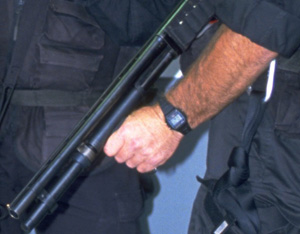 |
Rem870.com: Are there any drills you would recommend for shotgun owners?
Chris Costa: I would say if a shotgun owner actually carries a variety of 00 buck to slugs, doing slug changeovers are extremely important with the gun fully loaded. I would work on doing one to two slug changeovers and then with the gun starting off, empty the chamber (which is the way I carry my gun most of the time). |
If I do carry a shotgun and I have it in my car, or if I have it in my house, the tube’s loaded but the chamber is not. And that’s a great way to ensure safety with your gun – I really don’t want a round in a chamber unless it’s go time. If something bad happens, you can always chamber a round really quickly.
Now, at the moment during which I chamber a round, the dynamic of doing a slug changeover is completely different depending on whether the chamber is empty or whether the chamber has already got a round in there. Also, whether you do it with one or two slugs is also going to make an impact. There’s a lot of hand manipulation going on there, a choreography, so to speak, or a dance with your hands, that you actually have to perform so that you can really build-up an understanding of what needs to happen.
A lot of instructors will tell you that muscles have muscle memory, but the fact is muscles don’t have a memory in the way we tend to think of the term. There is no brain in your muscle. However, you can compare your brain to a hard drive, and if you upload good practices into that hard drive, you should see good results from your muscles. As they say, if you put in good information, you will get out good information – if you put in shit, you get out shit.
In my opinion, the most important thing to practice with a shotgun is the manipulation of it.
 |
Rem870.com: How is Costa Ludus different from other training companies?
Chris Costa: You know it’s hard to stretch and say that one training company is grossly different than another. |
There’s only so many ways to clear a malfunction and there’s only so many ways to speed reload a gun.
Fundamentals in trigger control, sight alignment, and picture are going to be taught by everybody across the board in pretty much the same way.
I think one of the differences that Costa Ludus brings to the table is its ability to diagnose the shooter. One of the most important aspects of what we do, at least in my opinion, is to help a person figure out what areas they need to improve on. If I’m there for three days, by the time I’m done, you know how to fix and identify your own problems. And I’m not talking machinery malfunctions – I‘m talking about if you are trying to put a bullet from point A to point B and you blow the shot. The difference between practicing on your own and not receiving any training or what other instructors teach is the fact that I am going to give you the understanding of how to make a correction, how to identify what you did was wrong. Then we’ll actually solve that problem and get that bullet back on track!
The thing that a lot of people don’t understand is that we will all make mistakes. I will go out and blow shots, and I will do things wrong. We’re all human, right?
The difference between, say, a novice shooter and an advanced shooter, are the practices of the fundamentals that allows you to duplicate results faster and faster based your foundation and your understanding. When you understand the fundamentals, you are able to practice them more efficiently and effectively.
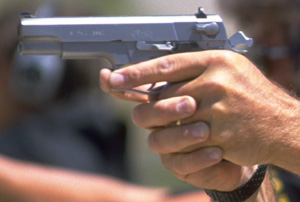 |
Rem870.com: Chris, tell us about other courses you offer.
Chris Costa: Ultimately, the basic courses are the ones I get a lot of enjoyment from. The handgun courses are great because we can carry handguns in most states legally. People carry guns on them, which means that they need to understand how to use them properly, and how to protect their families. |
We teach them how to be prepared in any situation, from home invasions to being out having dinner, being at a mall, or just hanging out with friends and enjoying their time – anywhere! The handgun is probably the most practical for civilians because it’s most likely the gun that they are going to shoot a target with.
I also really enjoy the Critical Infrastructure Assault course we offer – that is when I work with military and law enforcement. These courses are like playing chess for me; you don’t get to play complicated games all the time, but when you do get to start taking down buildings or performing ship boarding’s and taking over the vessels, it’s a nice change of pace. Dealing with problems and solving them on the fly is extremely important. It’s a mark of a good operator if you can process a problem and solve it extremely quickly. I enjoy being mentally tested in these situations, and helping other people improve their problem resolution reactions and skills. This course is awesome because it involves a lot of CQB, a lot of people movement, and extremely quick problem solving; I have a lot of fun.
Realistically, most of the people that I work with carry guns on them, specifically handguns. Whether you are a military professional conducting a low profile operation overseas or a security officer working close to home, your choice of weapon to carry on you is probably going to be a handgun. Your handgun is usually your first line of defense, at least until you can get to your carbine or get out of whatever situation you’re in that is compromising your safety. For a police officer, for example, a handgun is typically the first line of defense chosen until they can fight their way back to something bigger, such as a shotgun. Unless they roll up on the scene knowing exactly what environment their walking into, a handgun is often their first choice.
Consistently across the board, I find that the handgun is probably one of the most utilized weapon systems because it is the most wieldable and concealable, meaning you can always carry it on you.
One of the courses that I had this year was the 7.62 Heavy Course – and that is at 400 and in. The reason why we keep it at 400 and in is because most engagements are very close. When you look at going beyond 400 yards you’re getting into long range shooting, which at that point it gets little bit out of my expertise. If you’re going to get into long range shooting, that’s a completely different shotgun lifestyle. It involves complete devotion and understanding of shooting. I find there are a lot of rated rifle courses for 50 or 100 yards and in, but not much is taught in the full 0 – 400 yards range. 400 yards is actually pretty far away in regards to shooting, but most people don’t know what they can get away with in regards to a 400 yard shot. This course was just added this year, and it revolves around all the 7.62 guns that are on the market right now.
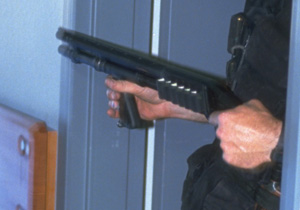 |
Rem870.com: Any other advice on upgrades for the Remington 870?
Chris Costa: The Vang Comp System is a very cool system. While it does assist with the recoil of the weapon, its most important feature is the way it chokes the gun down, meaning that it really tightens your pattern. Typically with a shotgun you want a wide pattern; however, a tighter pattern can be much more devastating. |
Think about that fortified cone going into a target at a high rate of speed – it’s going to destroy much more mass when it’s as centered as possible.
When you have nine 8mm projectiles spread out on a person it’s going through flesh, it’s causing an effect. But when you have that Vang Comp System or if you have a shotgun that’s got a choke on it, that pattern is much tighter. It ends up being like shooting a person nine times with a 9mm in a very close proximity; you’re going to destroy a lot more of that target, and the pattern is going to be much more focused. When you’ve cycled a gun a few times, you’re probably going to be able to run the guy three to four times. Now you’ve got these really tight groups of nine projectiles times three to four total rounds fired; you’re dealing with a lot of rounds that the target actually observed in a small amount of time.
Without a choke you are limiting your capacity; you can’t obtain the same amount of violence without one unless you’re firing a carbine full auto onto a target – there’s no way to make up that difference. With the Vang Comp System, with one pull of a trigger I’m essentially firing nine projectiles at you. With two pulls, I’m firing eighteen. When you start to look at that math, the person is getting hit by a lot of projectiles, and that Vang Comp System (or any choke, for that matter) becomes very important.
And that’s not even talking about having the ability to run the red dot on your gun, stretching out your ability for more precise shots when you’re shooting at a distance!
“Shotguns have limitations, but don’t underestimate the role you play in making your gun perform to the best of its abilities”
Rem870.com: Do you have any general advice for shotgun owners?
Chris Costa: I think it’s all a matter of practicality. I find a lot of guys in America, in a competitive world, walk around with 40 rounds on them. That’s extremely unrealistic. Nobody should walk around like that. You shouldn’t go out in public like that unless you’re trying to get shot or arrested.
When you’re going around with a shotgun, you should really only have what’s in it loaded, and what it carries as backup ammunition with a 12 gauge – yes, that means you end up being extremely limited. Even so, there are still pros to the shotgun and the way it works. If you’re dealing with a surrounding made of steel structures or certain types of hardened walls, you can actually bounce 00 buck off them. You can even bounce it off the ground, shooting people’s feet out from underneath a car if you skip your shot off the concrete at the right angle.
There’s a lot of versatility to what the gun can do. What you typically find is that the limiting factor of the gun isn’t just related to the gun, but also to its user. The gun is low capacity in regards to how many rounds it carries; it’s a pump, so it doesn’t work as fast because it requires you to actually do some work. The thing about this, and what it ultimately comes down to, is how the user employs that particular system under speed. It’s all about manipulating that weapon properly and how trained and practiced a person is. People need to work on their shotgun skills consistently to make sure that when they do find themselves in a situation where they need to use their gun in the face of a threat, they know how to perform and they can do so promptly and accurately.
So, shotguns have limitations, but don’t underestimate the role you play in making your gun perform to the best of its abilities.
Rem870.com Blog Readers’ Questions
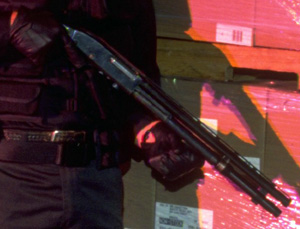 |
Rem870.com: What kind of slugs would you recommend using out of a smooth bore barrel?
Chris Costa: Remington has some really good slugs. Federal has some really good slugs. I think they make a BRI Sabot Slug and some of the Remington ones are almost like hollow points – they are really devastating rounds. |
The important thing to remember is you shouldn’t just be getting something that looks pretty on a box. You need to make sure the shot you purchase shoots and functions properly out of your gun. Just because it says Remington on the box, it doesn’t mean that it’s going to group well out of your gun. It may group well out of my gun, but Federal may actually group well out of your gun – every gun is a little bit different; know your weapon.
When you are dealing with 00 buck or slugs it’s extremely important to buy a box of each from different manufacturers and to look at your pattern and what your groups are with the rounds. And that’s not standing up, shooting at the offend – you should be benching a gun, laying down, bagging a gun, and taking your time to try shooting in a really tight group, or trying to shoot a really tight group with that particular load that you are trying in that moment of time.
It’s hard to tell you what you should run out of your gun because they are all slightly different. For the most part, I would say that any of the Federal Tactical loads seem to be extremely consistent from one gun to another, whether it’s an 870 or a semi-automatic Benelli.
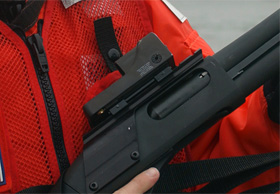 |
Rem870.com: Would you recommend using optic or a red dot sight on a shotgun?
Chris Costa: I like red dot sights. If nothing else, running a fiber optic front sight is definitely going to help you, but make sure it’s something more tactical, meaning not a typical 3-Gun style Ameriglo that’s going to break at the first sight. |
You need to make sure that if you do run a fiber on your gun, it’s protected. Secondly, the red dot does allow you to stretch out your zero; it allows you to get a little bit further and to be more precise. So, if shooting the shotgun at longer ranges is something that you think you are going to want to do, then a red dot is definitely going to assist you with that.
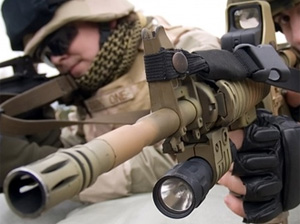 |
Rem870.com: What is the most important thing to remember in any tactical situation?
Chris Costa: It’s important to understand that if you practice with your firearm (shotgun, handgun, carbine), then you should be able to shoot on a more subconscious level. A lot of practice is extremely important. |
By not having to worry about whether or not you are manipulating your firearm correctly, you can focus on your environment and what is changing and unfolding around you. The last thing you want to do in a dangerous situation is to have to be worrying about the complexities of what’s happening with your gun; if you’re already comfortable solving those types of particular problems, your mind is free to pay attention to the most important thing – the threat, and how you need to react and counterattack in your situation.
I would say, shooting starts in a mind first – be comfortable with your equipment so you can focus on your surroundings.
“The focus now is to try to do something bigger than the DVDs”
Rem870.com: Do you have any exciting projects or products you can tell us about?
Chris Costa: Right now I’ve got a couple of media projects that I’m working on. I think that the focus now is to try to do something bigger than the DVDs. A lot of people ask me if I’m going to do my own DVDs or not.
What a lot of people don’t realize is that when I first got hired on by Magpul, Travis wasn’t on board yet, he hadn’t been hire. And that was when the company asked me what I thought about doing basic training videos. One of the things about the training videos that I saw was it was always one on one, and after a while it just kind bored me. And what I told them was, “You know, I don’t know whether you can do it or not, but if you could film a class that would be really cool.” But then I wasn’t sure if the student at home could actually learn from the class. So when we did the SWAT trailer – that was a test. And then after the Carbine 1 (I believe it was on the second disc), when we were in Georgia, Travis wasn’t there yet – that’s because he wasn’t hired by Magpul at that moment in time.
It all was done as a test, to see if we could film an entire class and incorporate three main ingredients:
• We wanted it to be entertaining.
• It needed to be educational.
• And, ultimately, we wanted it to be motivational to the shooting community. Whether people decided to go take someone else’s course or ours, it didn’t matter. We just wanted people to start training period, and to take it extremely seriously, like we did.
So, since I’ve been out a lot of people are like, “Hey Chris, are you going to do your own videos?” And the thing about it is, as far as videos go, the Magpul’s videos are actually pretty good. And at their cost of $49 – $59 for 2-10 hours of content it’s kind of hard to compete against that.
Now, I know some people like the one on one approach, but that’s not what I ever wanted. I liked when it was on me, and then on the students, then back to me, and finally on the students again. Then it went back and forth to where the entire video wasn’t just about me. And then Travis came aboard, and what it did was it created a bit more of an atmosphere. By the time a little bit of time had passed, you wanted to see one of us again because you hadn’t seen us for a while.
I think to try to duplicate that, well; it’s already been done before. I think it’s time to move on to other styles of projects. There are a couple projects that I’m just waiting on right now; I’ve got my fingers crossed, so we’ll see how it all unfolds.
“You can either fight or push against a system, or you can get out on your own and do your own thing”
Rem870.com: Why the departure from Magpul?
Chris Costa: Magpul was recently bought out by an investment group. To a certain degree, there’s going to be some changes to the beneficiaries and its overall structure; in general, there’s going to be changes made within that organization.
And a lot of people think that both Travis and I got royalties from the DVDs and the theory based products. The fact of the matter is that when I first joined Magpul, it was a huge risk to start the training division. I was openly promised only a one year contract. They told me one year is what they would offer me, and if it didn’t work out we would shake hands and part ways. It was a risk, but that was the way the deal was structured.
After that, as the program grew and the DVD collection became larger and larger, nothing was changed within my contract. There were discussions about obtaining some ownership over Magpul Dynamics, but in the end nothing ever happened. Nothing could be agreed upon. So what I found was that you can either fight or push against a system, or you can get out on your own and do your own thing.
I appreciate everything that those guys have done for me, and I think I we did a lot of good things for Magpul as a company together. But now it’s time to do my best to capitalize on opportunities for myself.
The thing about it is it’s not a matter of being greedy, it’s just a matter of being fair. If you are making millions of dollars on the theory based products and on the DVDs (and yes, they made millions of dollars), then pay me what’s fair. At the end of the day, there’s no staking a gain for me, no ownership, or nothing in writing anywhere that entitled me to a fair share of what was being accomplished and actualized.
It’s just one of those things. Based on the position I was in at the time with the company, I should have pushed for more. I don’t know how to describe it – you always think people are looking out for your best interest, but really, no one’s going to look out for you but you! It comes with the job, so to speak. It’s just one of those things.
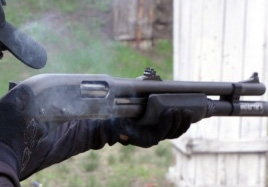 |
Rem870.com: What do you like and what you don’t like about the Remington 870 shotgun?
Chris Costa: The stock Remington’s – they’re good guns! I like them. But, I definitely prefer the ones manipulated by Nighthawk, because the actions are worked over a little bit. |
That roughness that you get with the typical 870, is already taken out of the equation.
The barrels are Vang Comp-ed and the sights are different on the gun, so you run more of a ghost ring, and you can either run a Tritium front sight or a fiber optic if that’s what you choose. You can have a rail system embedded into it to where you can attach a red dot, if that’s something that you would like to do. And then, generally the controls are enlarged, such as the safety mechanism.
You can get them pre-setup with the right configuration as far as the stock. Now, typically I like running a standard stock because I can spin it in my hand fast; when I need to spin it, throw a shell in, and do a combat reload or spin it and actually feed the tube it makes a difference. To me, believe it or not, the ergonomics of a pistol grip with my wrist, especially running it back and forth, binds me; I feel I can spin a gun a lot faster with a standard stock.
I personally feel that the Remington 870 stock needs some work done to it.
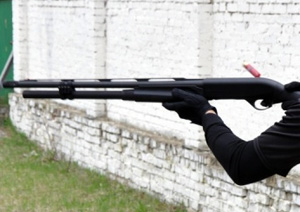 |
Rem870.com: What would I learn from the Shotgun Employment course?
Chris Costa: Generally, you’ll learn a lot of recoil management. How to employ the gun, how to feed the gun, and how to actually manipulate it when it comes to slug changeovers whether it’s a cruiser safe configuration (which basically means empty chamber), fully loaded tube, or whether the tube is fully loaded and there’s one in a pipe (which means cruiser ready). |
What you definitely find in a course, is that by the time you are done you can quickly manipulate the gun and feed it very, very quickly. And you can shoot it and employ it fast without it kicking your ass. I can run a 3-day shotgun program firing nothing but law enforcement ammunition and I can tell you I won’t have any bruises on my shoulder and I’m not going to be fatigued at the end of those three days. If I do everything correctly, if I stretch the gun every time I break that shot, I am going to mitigate the amount of recoil that’s actually going into my body, especially in my shoulder area.
I think what a lot of people do is they show up shooting the way their dad taught them how to hunt. And by the time they are done, one of two things are going to have happened: they are either going to understand what it is that I am talking about in regards to mitigating recoil and manipulating the gun, or for three days the gun’s going to kick their ass the entire time out there on the range.
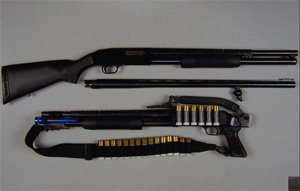 |
Rem870.com: Do you plan to make training available abroad?
Chris Costa: The State Department, really heavily regulates instructors going overseas and legally conducting training courses. |
There are a couple of negatives with going overseas. If I’m in America and I’ve got to travel to California or somewhere, you figure it’s about $500 for a plane ticket, and a hotel is probably $80 a night to stay somewhere, and I need to rent a car.
Typically for overseas travel, some of the airplane tickets (even flying coach) can be upwards of $800 to $2,000. So that’s a pretty big cost right there. And then you have to deal with hotels overseas, and car rentals overseas. And there are the State Department and lawyer’s costs and legal fees, which are generally going to run about $3,500 to $4,000 for the State Department approval to take place. And if my lawyer submits all my paperwork and I get declined then I’m just out all that money!
If you think about what I just said, between the plane ticket, the lawyer fees, and the hotel and car rental, you’re likely spending at least triple the cost to go overseas compared to traveling throughout the United States. So, as far as course costs, I’d have to charge an extreme amount of money to ensure the trip was a wise business choice, assuming all my authorizations went through. And as far as profit margin goes – it’s a lot easier to make a profit within the United States because of the way the travel system works.
I tell people that if they are a military unit or a law enforcement unit, you can probably get it to where I can come over. There’s going be a cost associated with that and it’s not going to be the same cost as a course in America; it’s going to be much more expensive, for the reasons I’ve already listed. I don’t have to worry about all those high costs when I travel in America like I would if I went overseas.
If a government or that agency solicits through the State Department and says, “We want Chris Costa come over and train our guys,” then a lot of times we’ll get the green light a lot faster. It’s never denied if the request comes from a country that is friendly with the United States.
There’s just a huge cost associated to all that.
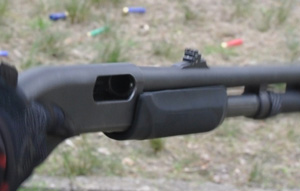 |
Rem870.com: Do you have any dry fire drills you could recommend for shotguns?
Chris Costa: As far as dry fire drills go, you can dry fire combat reload, you can obviously speed reload, and you can also work in slug changeover drills. All of those are dry fire drills, and they’re all done with manipulating rounds in and out of the actual gun. |
At the end of the day though, you’re going to have to fire that gun. A lot of times people get very relaxed when they dry fire. They’re not in the stance they normally would be in, because there’s no recoil, the gun’s not going to kick them, and there’s not big explosion. Dry firing, as far as the weapon manipulation and ammo in, ammo out, feeding the gun and also combat reloading a gun, all of those things can be drilled. Just make sure you practice live firing, and not only dry drills.
“When you’re in a close gunfight you need to be 100% focused on the threat
Rem870.com: What are your thoughts about shoulder to shoulder transitions using a shotgun?
Chris Costa: I actually don’t do that.
First, whenever you’re running iron sights, you’re going to have to close an eye to actually see down it. When you’re running an optic, the way your eye takes in that information is a lot different, because an optic is something dead center in the middle of your gun. You don’t have to try to line up objects, meaning the rear sight and the front sight.
For people to just shift from one shoulder to another running optics – it’s a lot easier. However, you also have to deal with the coordination of now running a pump, feeding the gun, and shooting it off your left shoulder. Accurateness generally decreases extremely.
On a carbine it’s a lot more forgiving because of the way it recoils. And then you’re typically dealing with a red dot. When we have a student show up with a carbine with iron sights it gets difficult to teach because they have to close one eye. The reason why I’m a bit against irons is because you shouldn’t be closing an eye during a gunfight. When you’re in a close gunfight you need to be 100% focused on the threat. That means that you’re not going to be able to shift your focus back to the rear sight, line up the front sight, and then line everything up on a target and fire. With the red dot something floats between you and the other person that requires no lining up other than putting the dot on the target’s chest, and then you can pull the trigger.
When you talk about the typical, average shotgun, it doesn’t come equipped with an optic. You start off right away learning to close an eye, which isn’t necessarily good. I know that you won’t be able to see down the gun sight the way you need to whether or not you have irons because of the recoil management and awkwardness of the platform.
With a carbine, all you have to do is hold it still and pull the trigger; control it and cycle the gun.
I don’t usually recommend on 12 gauges, or shooting big 7.62 guns, and I generally don’t advocate switching shoulders.
“I have a Nighthawk Remington 870 and my semi-autos include a Benelli M1 and a Benelli M4.”
Rem870.com: What shotgun do you have?
Chris Costa: I have a Nighthawk Remington 870 and my semi-autos include a Benelli M1 and a Benelli M4.
The M1 is a lot lighter because you’re dealing with an aluminum receiver; it’s probably one of my favorite guns. The receiver’s been cut out to have an RMR Trijicon placed on top of it, so it’s extremely low, and I believe it holds 10+1 in a pipe, so 11 rounds in that gun, which definitely helps for not having to load as much.
The Benelli M4 is a beefier gun. It’s going to take a lot more abuse and has more of a military and law enforcement capacity as far as dropping it, jumping it, or getting it wet, but it’s also a heavier gun.
As far as semi-autos, I love the Benelli because of the way I can manipulate it and change my load out. And as far as pumps go, I prefer the 870.
“If I want to buy something based on looks, the stock definitely meets that requirement”
Rem870.com: What do you think about stock and forend for the Remington 870 by Magpul?
Chris Costa: I was brought into that project by the time the mold was just about fully complete. When they showed it to me my input was very minimal on it. I prefer the Surefire integrated weapon light forend to the Magpul forend. The Magpul forends are a little slippery, so as far as cycling a gun I don’t really care for it.
As for the stock, it has its ups and downs. It has an easy integration of the cheek pieces, and the ability to change the length of the pull on the actual stock of the gun. The drawback to it is that it’s freaking heavy. Weight doesn’t really seem to concern engineers for some reason, but when you have to start carrying this gun around, running with it, that weight is an extreme problem to the user. What I find is that the ability to change the cheek and the length of pull are both a huge positive on that stock, and the weight is non-negotiable for the average person.
If I want to buy something based on looks, the stock definitely meets that requirement. As far as functionality goes, there’s part of there, but a huge part is missing. It simply needs to weigh less. The shotgun is built out of steel as it is; it’s a freaking heavy gun, which can make it hard for people to shoot, carry, and employ. Adding weight is definitely not something that I really want to do.
I was little disappointed by the time I was able to implement changes, just before I left Magpul. They pretty much already had the mold done, and there wasn’t much as far changes I could recommend. Unfortunately, that was poor integration between Dynamics and Magpul. In a lot of cases you would think that in the early stages of them starting a new product we would be brought in really early to understand who the user was and what we were actually trying to achieve as a company to make sure everything stayed consistent all the way throughout the entire project. In many cases what happened is we would be brought at the very end when it was almost virtually, in many cases, too late to change things because it had gone so far down the line and a lot of money was already spent on getting it there.
That was an unfortunate disconnect between Dynamics and Magpul.
So, do I like the stock? There are attributes that I like about it, but the weight has got to go. It’s a tank!
 |
Rem870.com: Please tell us more about Costa Ludus.
Chris Costa: Primarily, Costa Ludus is trying to build more efficient shooters that can problem solve and also self-diagnose their shooting abilities. |
The other side of it is marketing. We definitely try to market for a lot of companies because we are able to, and we do have a little bit of push within the industry. I’m pretty honest about things; I think most of the people know that
I’m pretty humble. If I haven’t shot it or if I don’t know, I’m not going to act as if I did. If I’ve shot it, if I seen it, if I see it over and over in a class, then I’m going to comment on it.
I think people understand as far as the marketing side of the house goes, it can be a pro and a con. If your product does really well, then Costa Ludus is a great marketing tool; if it doesn’t, Costa Ludus probably isn’t the greatest marketing tool for your company, especially if somebody asks about it. That can be a problem. But, remember that the most important person out here isn’t the company, it’s the shooter. And making sure that that a shooter is getting their money’s worth from whatever product they decided to buy, whether it’s a gun to an optic, to an accessory or a piece of plastic or a magazine, it doesn’t matter. That’s a lot of hard earned dollars from the shooter, so it’s extremely important.
Then there’s the media side, which is in regards to some of the other media projects that I have going on right now, which will hopefully be finished by the end of this year.
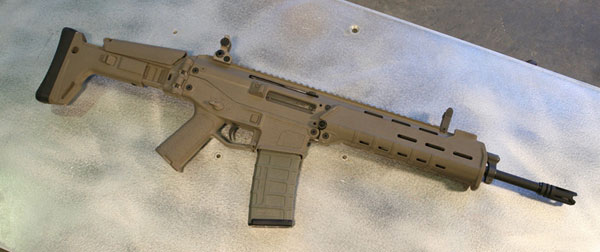
Magpul Masada ACR
Rem870.com: Do you think that there will ever be a rifle that will reach the same level as the AR in the US?
Chris Costa: I had a lot of hopes with the MASADA when Magpul had it, and when it got licensed to Remington.
They changed the charging handle from the middle of the receiver to the front end of the gun. I know this was in order to prevent dirt and different things from entering the receiver area, but the AK-47, the M14, and the FAL seem to have no problems dealing with a charging handle located in the middle of the gun and being exposed to the elements. I thought that was a very poor decision that was made by more engineers than actual shooters; by the time I’m trying to get a normal grip on the gun, the charging handle is in the way of not only the laser but where I put my optic. I don’t put my optic in the back end of the gun; I put it up towards the middle of the gun, as center-lined as possible. Simply put, the charging handle gets in the way of how you shoot, your laser, and the damn optic. You couldn’t put more in the way for the user!
I actually thought with the interchangeability and the light weight of that particular platform that it was going to be a show stopper, but I only see a 60% success rate with the current ACR out in the market in my classes. Good ammunition – and the gun runs 60% of the time.
I am very eager to see the new enhancement that they did to the ACR, to see if that actually performs better than the existing ACR.
The ergonomics on the ACR, except for the charging handle, are really good. The ergonomics are much better than the FN SCAR. The FN SCAR is not the most ergonomic piece of equipment out there, but the reason why I would run a SCAR before an ACR right now is because the god damn thing works every time I pull the trigger. No matter what ammo I put in – the damn thing works! Whether I shoot on the ground or off the ground, it doesn’t matter. That gun works every single time from what I see when it comes through my courses over an extended period of time. And it’s not just one gun; it’s a multitude of guns, constantly, every single time in class. And every time I see an ACR, the student ends up having some type of problem, malfunction, or headache with it.
It does sadden me, because I truly thought that gun was going to be the one that replaced the AR15. Maybe it’s still can, but I’m not sure anymore.
Rem870.com: What ammunition would you recommend for shotgun home defense?
Chris Costa: I like the Federal Flight Control.
Rem870.com: Is there any use for magnum rounds with 12 gauge buckshot in a round?
“Most people can’t even handle shooting a 12 gauge under normal conditions”
Chris Costa:Most people can’t even handle shooting a 12 gauge under normal conditions. Running larger, like 3.5 in it, it’s like, “Goddamn, they better hit the target!” But, I really don’t see utilizing that particular round unless you are going out and hunting something that’s a lot bigger than you. I’ve never really used 3.5. Not to say that you can’t – I’m just not sure what you’d actually be going after that’s going to require that big of a cartridge. Plus, it does limit the capability and capacity of the gun in regards to how many rounds you can carry.
You definitely have to worry about controlling the gun more in regards to recoil management, even more than what you do with a standard 12 Gauge. And not only that, but you’re limiting your round capability; you literally end up with a gun that holds 4 rounds, and 4 rounds runs out very, very quickly.
Rem870.com: Do you apply any pressure to the forend in a backward direction prior to pressing the trigger for faster follow up?
Chris Costa: This is something that you learn over the course of time. When shooting, you stretch the gun when you fire it, and then you have to collapse the gun, cycle the gun and then stretch it and fire at the exact same time. It definitely becomes a little bit of a musical dance so that you can mitigate how much recoil you feel to your shoulder area when employing the gun.
You have to have a technique to stretch the gun and collapse it, and it takes time to learn that. There’s a large timing issue that you need to master. That’s one thing that’s hard to do with dry fire. You can practice a little with dry fire, but where you really notice it is when you actually have live ammunition coming out, because you know what feels wrong very quickly.
 |
Rem870.com: Do you have any general advice or recommendations for shotgun owners?
Chris Costa: Shotguns are not for everybody. Just because you can buy one, it doesn’t mean that it’s right for you. Just because they sell a 44 Magnum in a gun shop, it doesn’t mean that you are the guy who can actually shoot and handle it. |
Bring enough gun to the fight, but bring to the fight what you can actually control and handle. And shot placement is extremely important. Don’t ever think that there is a magic bullet out there. Your ability to drive the gun, control the recoil and get round on the target, and actually move the gun from location to location will be more important and vital than any type of magic bullet or ammunition that somebody is trying to guarantee you. At the end of the day, shit gets in the way; there’s clothing, there are chairs, walls, and there are mediums in between you and your threat that the bullet is going to encounter that you have to take into account. This means that something might deflect, or the penetration might not do what you thought it was going to do.
You need to be able to control what it is that you’re shooting. The shotgun may be a little too complex for you, especially if you don’t train on it consistently. And by train consistently, I mean that every few weeks you should run through a training session with that particular gun. If you are putting it in a closet and 6 months later you are going to grab the thing and shoot it – that’s not devotion. You are not going to do well when something bad happens if you’re not familiar and well-practiced with your gun.
Keep it real and keep it practical. And don’t be sad if the shotgun is not for you. I certainly would recommend handguns to the average male or the average female for home defense. I would rather someone shoot a 9mm handgun and control it and have 18 rounds that they can surgically place on a target. I would rather they can move from one location to another and clear their house extremely fast and wield their weapon that much easier. I would rather they can shoot it and employ it, even if they get injured, extremely quickly.
Employing a shotgun one handed in a home defense role is very, very difficult. Picture your wife trying to hold your shotgun one handed, when she could have employed her handgun one handed a lot easier.
At the end of the day – it’s not for everybody.


